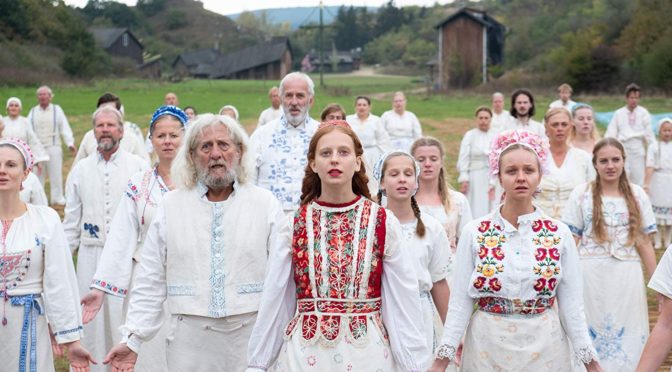MIDSOMMAR, Ari Aster’s much-anticipated followup to HEREDITARY, leads us through the agony of loss and alienation, and into the mesmerising depths of cultish insanity.
Although Aster himself is loath to classify MIDSOMMAR as a horror film, referring to it as “an operatic break-up movie’”, and a “dark contemporary fairy-tale”, he also sees it as a “horror story about codependency”. Indeed, the film centres on the faltering and unhealthy relationship between the main characters and how they fare amongst the eerie folk rituals of the cultish Hårga peoples as much as it does on gore or jump-scares. This film is ultimately a demented form of catharsis.
Aster directs horror much better than most in a genre haunted by agonising tropes and hackneyed fear-mongering techniques. He maintains crisp artistic integrity, authenticity and the ability to make grisly, anxiety-inducing scenes that are so visually impressive and mesmerising you cannot escape a visceral reaction. He is a master of the kind of hyper-realism that drags your own experiences of suffering and fear – kicking and screaming – into the disturbing vortices he creates. There is no way you can sweep MIDSOMMAR under the comforting rug of the supernatural; the fiction beyond the possible. Unlike HEREDITARY, all the suffering here is man-made; borne of madness, gaslighting, mind control, anguish and the frequent use of psychotropic drugs.
“Aster has created a fantastically pleasing cultish microcosm in which to trap his victims, replete with a rich visual dialect…”
Filled with fantastically detailed elements of folk horror and legend, MIDSOMMAR will undoubtedly go down in history as a classic of the genre. Aster has created a fantastically pleasing cultish microcosm in which to trap his victims, replete with a rich visual dialect, and set of traditions which echo those of real and varied European cultures. That the rituals and beliefs played out in the film are so similar to those belonging to our ancestors posits just how easy it would be for us to slip back into such collective insanities – and how prone we are as humans to such strange behaviours.
Given that desires for utopian and bucolic hippy lifestyles are back in vogue, MIDSOMMAR seems particularly eerie. Just as THE WICKER MAN played on scepticism towards hippy and pagan movements which hoped to carve a better future by harking back and forming tight collectives, MIDSOMMAR considers the nature of cults, codependency and insidious group-think. Stunning visual metaphors and subtle effects allow the film to consider the importance of inclusion in social groups, and the vitality of ritual to mankind in our search for meaning, order and belonging.
Deriding MIDSOMMAR for its few similarities with THE WICKER MAN or its familiar folk-horror elements would mean completely jettisoning the unique and wonderful horror Aster is so adept at creating. The establishing sequences before so much as a folky floral wreath or creepy Aryan cult-member are even hinted at could easily be an award-winning horror short on its own. MIDSOMMAR is nuanced and subtle; finding room to be funny, subversive, relatable, ridiculous, hypnotic and grotesque.

